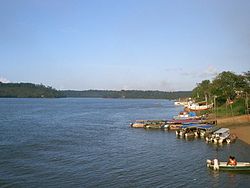geo.wikisort.org - River
The Oyapock or Oiapoque (/ˈɔɪ.əpɒk, ɔɪ.əˈpoʊki/; French: Fleuve Oyapock [flœv wɑjapɔk]; Portuguese: Rio Oiapoque [ˈʁiu ɔjɐˈpɔki]) is a 403-kilometre (250 mi) long river in South America that forms most of the border between the French overseas department of French Guiana and the Brazilian state of Amapá.[1][2]
This article needs additional citations for verification. (April 2014) |
| Oyapock | |
|---|---|
 View of the Oyapock River from Brazil toward French Guiana | |
 Guyane Oyapock River map | |
| Location | |
| Countries | Brazil and France |
| Physical characteristics | |
| Source | |
| • location | Tumuk Humak Mountains |
| Mouth | |
• location | Atlantic Ocean |
• coordinates | 04°14′08″N 51°36′53″W |
| Length | 403 km (250 mi) |
| Discharge | |
| • average | 1,428 m3/s (50,400 cu ft/s) |
| Basin features | |
| Bridges | Oyapock River Bridge |
Course
The Oyapock runs through the Guianan moist forests ecoregion.[3] It rises in the Tumuk Humak (Portuguese: Tumucumaque) mountain range and flows into the Atlantic Ocean, where its estuary forms a large bay bordering on Cape Orange.
The mouth of the Oyapock is the northern end of Brazil's coastline, as it is where the border between Brazil and French Guiana meets the ocean, but nearby Cape Orange, which separates the Bay of Oyapock from the Atlantic Ocean, is the northernmost point of the Brazilian coast. In Brazil, both the cape and the mouth of the Oyapock are often mistaken for the whole country's northernmost point (rather than just of its coastline), and in the past this information could even be found in geography schoolbooks.[4] Yet the true northernmost point in Brazil is actually far inland, on Monte Caburaí, in the state of Roraima, hundreds of kilometers from the Oyapock and almost a full degree more to the north.[4]
History
Vicente Yáñez Pinzón was said to be the first European person to see the Oiapoque River in the first years of the 16th century.[5] It has been rendered Japoc, Yapoc, Iapoco, Wiapoco, and even called the Vicente Pinzón River. Early European colonists referred to the river as the Wiapoco, and it was the site of early settlements by Briton Robert Harcourt in 1608 and Dutchman Jan van Ryen in 1627. The name Oiapoque has been officially used from 1900, when a territorial dispute between Brazil and France was resolved through Swiss diplomatic arbitration.
Settlements
In addition to the small towns of Oiapoque (Amapá) and Saint-Georges de l'Oyapock (French Guiana), there are some small villages scattered along the bank of the Oyapock, such as Camopi and Clevelândia do Norte.
Bridge
The Oyapock River Bridge has been built across the river to connect the Brazilian town of Oiapoque and the French town of Saint-Georges-de-l'Oyapock. It is the first international land border connection of French Guiana, but although completed since 2011, as of February 2017 it remains closed to traffic, due to delays in making the final payments to the construction company, building and staffing the Brazilian customs facilities, and some minor disagreements between the Brazilian and French governments.[6] The inauguration ceremony of the bridge finally took place on 18 March 2017. Starting from 08:00 on 20 March 2017, the bridge has been open to members of the public.[7]
In popular culture
The widespread Brazilian Portuguese expression "do Oiapoque ao Chuí" ("from the Oyapock to the Chuí [rivers]") is used to refer to the whole nation, by mentioning the waterways that mark respectively the northern and southern extremities of the Brazilian coastline (as noted above, they are often mistaken for the entire country's northern and southern extreme points). Thus, the saying is used in the same way as Americans use the expression "from coast to coast."
See also
- Rings of Chariklo, one of which is named "Oiapoque" after the river.
- List of rivers of French Guiana
- List of rivers of the Americas by coastline
References
- Sandre. "Fiche cours d'eau - oyapock, l' (fleuve); kerindioutou (riviere) (6---0000)".
- "Oyapock: the bridge to discord?". France 24. 2012-09-07. Archived from the original on 2014-04-14. Retrieved 2014-04-13.
- Schipper, Jan; Teunissen, Pieter; Lim, Burton, Northern South America: Guyana, Suriname, French Guiana, northern Brazil, and eastern Venezuela (NT0125), retrieved 2017-04-03
- "Expedição ao Monte Caburaí, extremo Norte de RR, completa 17 anos" [Expedition to Mount Caburaí, northernmost point of Roraima, was 17 years ago]. G1 (in Portuguese). 2015-09-08. Retrieved 2017-02-28.
- "Ornamental Garden Plants Of Th Guianas" (PDF). Wilderness-explorers. Retrieved 2014-04-13.
- Lissardy, Gerardo (2016-01-03). "A ponte entre Brasil e Guiana Francesa que ninguém pode cruzar" [The bridge between Brazil and French Guiana that nobody can cross]. BBC Brasil (in Portuguese). Retrieved 2017-02-28.
- Catherine Lama (18 March 2017). "Le pont de l'Oyapock inauguré et officiellement ouvert à la circulation" [The Oyapock bridge inaugurated and officially open to traffic]. Guyane 1ère (in French). Retrieved 25 March 2017.
На других языках
[de] Oyapock
Der Oyapock oder Oiapoque ist ein Fluss in Südamerika. Er bildet die Grenze zwischen Französisch-Guyana und Brasilien, bis er in den Atlantik mündet.- [en] Oyapock
[es] Río Oyapoque
El río Oyapoque[1] (en portugués Oiapoque y en francés Oyapock) es un río sudamericano que forma la frontera entre el departamento de ultramar francés de la Guayana Francesa y el estado brasileño de Amapá. Nace en las montañas Tumuk Humuk (Tumuc-Humuc) y fluye hacia el océano Atlántico.[it] Oyapock
Il fiume Oyapock o Oiapoque (in francese Fleuve Oyapock; in portoghese Rio Oiapoque) è un fiume sudamericano che segna buona parte del confine internazionale tra la Guyana francese ed il Brasile.[ru] Ояпок (река)
Ояпо́к, Ояпо́ки[комм. 1] (фр. Oyapock [wɑjapɔk], порт. Oiapoque [ɔjɐˈpɔki]) — пограничная река между Французской Гвианой и бразильским штатом Амапа[1].Другой контент может иметь иную лицензию. Перед использованием материалов сайта WikiSort.org внимательно изучите правила лицензирования конкретных элементов наполнения сайта.
WikiSort.org - проект по пересортировке и дополнению контента Википедии